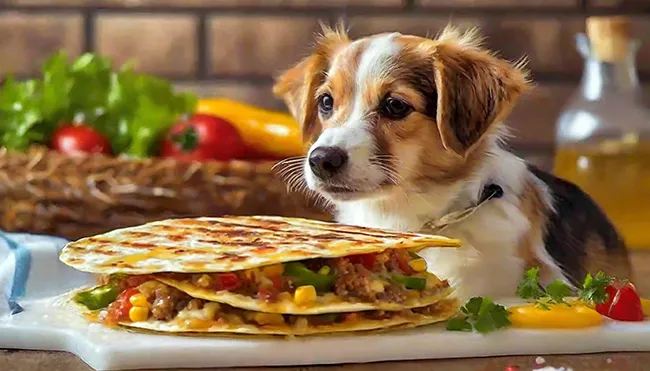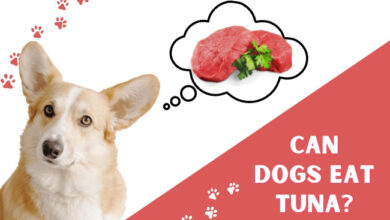
Imagine sitting down with a cheesy, delicious quesadilla, only to find your dog’s eyes pleading for a bite. You might wonder, “Can dogs eat quesadillas?” All dog owners need to know which foods are okay for their pets and which ones could be harmful. This guide is easy to understand and tells you what you need to know about sharing your quesadilla with your dog. Let’s find out together if it’s safe to share that tasty treat with your furry friend.
What Are Quesadillas?

A quesadilla is a traditional Mexican dish made by filling a tortilla, primarily with cheese, and optionally including meats, spices, and other fillings. It is then cooked on a griddle or stove. While the authentic version of the dish uses a corn tortilla, flour tortillas are also commonly used to prepare quesadillas. The versatility of the ingredients allows for a wide range of flavors, making it a popular choice for a quick and delicious meal.
Can Dogs Eat Quesadillas?
No, dogs should not eat quesadillas. While the essential components of a quesadilla—mainly tortillas and cheese—may not be immediately harmful in small quantities, quesadillas often contain ingredients that can be dangerous for dogs. These include onions and garlic, which are toxic to dogs and can lead to gastrointestinal upset and potentially more serious conditions like anemia.
Additionally, the high-fat content from cheese and any added meats can cause pancreatitis, a severe and painful condition. Many dogs are also lactose intolerant, so consuming cheese can lead to digestive issues like diarrhea and vomiting. Furthermore, the spices and seasonings typical in quesadillas, such as salt, chili powder, and cumin, can be irritating or harmful to dogs. It’s best to stick to dog-safe treats and consult with a veterinarian about suitable dietary choices for your pet.
The Risks of Feeding Quesadillas to Dogs
Before sharing your quesadilla with your dog, consider the following risks:
- Onion and Garlic Toxicity: Many quesadillas contain onions and garlic, which are toxic to dogs. These ingredients can cause gastrointestinal irritation and could lead to red blood cell damage and anemia in severe cases.
- Dairy Issues: The primary ingredient in quesadillas, cheese, is a dairy product. Many dogs are lactose intolerant, meaning they can’t properly digest lactose, leading to stomach upset, diarrhea, and vomiting.
- High-Fat Content: Cheese and any added meats in quesadillas can be high in fats, which is harmful to dogs. High fat intake can lead to pancreatitis, a severe and potentially fatal condition in dogs.
- Spices and Seasonings: Spices used in quesadillas, such as chili powder or cumin, can be irritating to a dog’s stomach. Moreover, excessive salt and certain seasonings can be toxic to dogs.
Safe Alternatives Quesadillas

Creating dog-friendly alternatives to human foods like quesadillas requires careful consideration of canine dietary needs and restrictions. While traditional quesadillas contain ingredients that may not be safe for dogs, such as onions, garlic, and certain spices, there are plenty of ways to modify this dish to make it a healthy treat for your furry friend. Here’s how you can make a dog-safe quesadilla:
Ingredients
- Whole Wheat Tortillas: Choose plain whole wheat tortillas as they are safer and healthier for dogs compared to white flour tortillas. Ensure they are free from any artificial sweeteners like xylitol, which is toxic to dogs.
- Cheese: Opt for low-fat cheeses such as mozzarella or cottage cheese in moderate amounts. Cheese is tasty, but it can be high in fat, so it’s important to use it sparingly to avoid digestive upset or weight gain.
- Cooked Meat: Cooked, plain chicken or turkey breast, without any added spices or garlic, is a great source of protein for dogs. Make sure the meat is well-cooked and avoid using any oils or butter.
- Vegetables: Some dogs enjoy vegetables like cooked carrots, spinach, or zucchini. These can be added for extra nutrition but should be cooked without any spices or seasonings.
Directions
- Prepare the Ingredients: Cook the meat thoroughly and cut it into small, bite-sized pieces. If you’re adding vegetables, steam or cook them until they’re soft, then chop them into small pieces.
- Assemble the Quesadilla: Lay out a whole wheat tortilla on a clean surface. On half of the tortilla, sprinkle a small amount of cheese. Then, add your cooked meat and optional vegetables over the cheese. Fold the tortilla in half.
- Cooking: Heat a non-stick skillet over medium heat. Place the quesadilla in the skillet and cook until the tortilla is lightly browned and the cheese has melted, about 2-3 minutes on each side. No need to use oil or butter; the tortilla will toast nicely on the dry skillet.
- Cool and Serve: Allow the quesadilla to cool completely before serving it to your dog. Cut it into manageable pieces to prevent choking and to make it easier for your dog to eat.
Important Considerations
- Moderation is Key: Even dog-safe treats should be given in moderation. Treats should not make up more than 10% of your dog’s daily caloric intake to maintain a balanced diet.
- Watch for Allergies: Just like humans, dogs can have food sensitivities or allergies. Introduce new foods slowly and watch for any signs of allergic reactions or digestive distress.
- Avoid Toxic Ingredients: Never include onions, garlic, avocado, grapes, raisins, chocolate, or anything containing xylitol in your dog’s food, as these are toxic to dogs.
By following these guidelines, you can create a tasty and safe quesadilla alternative for your dog. This not only offers a special treat but also ensures you’re keeping your pet’s health and safety in mind.
What to Do If Your Dog Accidentally Eats a Quesadilla
If your dog accidentally eats a quesadilla, it’s important to monitor them closely for any signs of distress or illness, especially if the quesadilla contains ingredients that are known to be harmful to dogs, such as onions, garlic, or high amounts of dairy and fat. Here’s what you should do:
- Assess the Amount Consumed: Determine how much of the quesadilla your dog ate and the specific ingredients it contained. A small bite may not cause much harm, but larger quantities, especially of toxic ingredients, pose a greater risk.
- Watch for Symptoms: Look out for signs of gastrointestinal upset, such as vomiting, diarrhea, excessive gas, lack of appetite, or lethargy. Also, be alert for symptoms of more severe conditions like pancreatitis, which can include abdominal pain, hunched back, or repeated vomiting.
- Provide Water: Ensure your dog has access to plenty of fresh water to help dilute any potential irritants they may have ingested.
- Diet Adjustment: Depending on what your dog ate, you might need to adjust their diet temporarily. For minor stomach upset, a bland diet of boiled chicken and rice can help settle the stomach.
- Contact Your Veterinarian: If you know your dog has eaten something potentially toxic (like onions or garlic), or if they start showing any symptoms, contact your vet immediately. They can provide advice specific to your dog’s situation and may recommend bringing them in for an examination.
- Emergency Care: In cases of severe symptoms, such as continuous vomiting, diarrhea, signs of pain, lethargy, or any behavior that is unusual for your dog, seek veterinary care immediately. Your vet may need to perform tests, administer fluids, or provide medications to treat symptoms.
- Prevent Future Incidents: To prevent similar incidents, keep all foods out of your dog’s reach and educate everyone in the household about which foods are unsafe for dogs.
Remember, each dog reacts differently to ingesting human foods, depending on their size, the quantity of food they eat, and their overall health. When in doubt, it’s always best to consult with a veterinarian to ensure the safety and well-being of your pet.
Conclusion
While it might be tempting to share a quesadilla with your furry friend, the potential risks outweigh the benefits. The ingredients commonly found in quesadillas can pose several health risks to dogs. Always prioritize your pet’s health and well-being by choosing dog-safe foods and consulting with your veterinarian before introducing new foods into their diet. Remember, a well-informed pet owner is the best defense against potential food-related health issues.
Read More:
- Can Dogs Eat Cumin?
- Can Dogs Eat Banana Peels?
- Can Dogs Eat Octopus?
- Can Dogs Eat Oatmeal Cream Pies?
- Can Dogs Have Provolone Cheese?
- Can Dogs Eat Egg Rolls?
- Can Dogs Eat Tamales?
- Can Dogs Eat Yellow Rice?
- Can Dogs Eat Babybel Cheese?
- Can Dogs Eat Plantain Chips Safely?
- Can Dogs Eat French Toast?
- Can Dogs Eat Veggie straws?
- Can Dogs Eat Rotisserie Chicken?
- Can Dogs Eat Orange Chicken?
- Can Dogs Eat Durian Safely?
- Can Dogs Eat Cheerios?
- Can Dogs Eat Couscous?
- Can Dogs Eat Funyuns?
- Can Dogs Eat Acai?
- Can Dogs Eat Tuna?
- Can Your Dog Eat Onions?
- Can my dog eat this?




